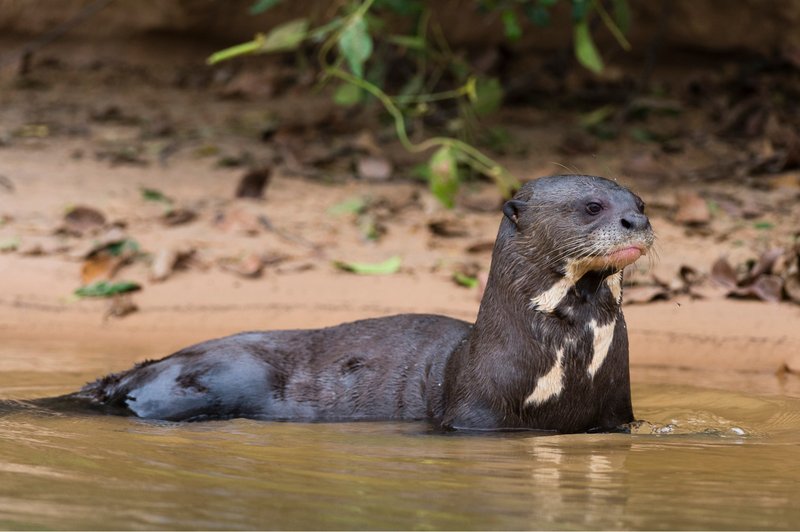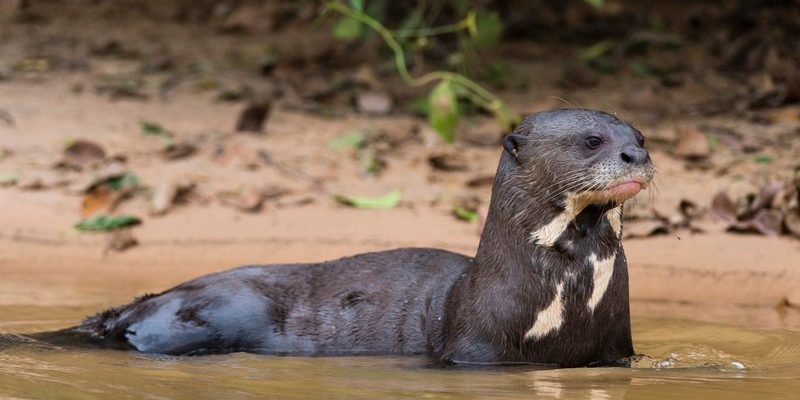
Imagine a sleek, furry superhero of the waterways, darting effortlessly through rivers with a playful spirit and a crafty hunting strategy. The giant otter, which can grow up to six feet long, is found primarily in South America, specifically in the Amazon Basin. Not only do they have incredible physical attributes, but they also play a vital role in their ecosystems. Let’s dive into some fascinating facts about these creatures that will leave you in awe!
1. Size Matters: The Giant Otter’s Impressive Dimensions
The giant otter is aptly named for its size. Averaging around 5.5 to 6.5 feet in length, these otters are the largest of their kind. Imagine a furry noodle swimming along the river—it’s quite the sight! Their weight ranges from 50 to 90 pounds, depending on diet and habitat.
What’s even more impressive is their streamlined bodies, which help them glide gracefully through the water. With webbed feet and a thick, muscular tail, they’re built for speed and agility. This size isn’t just for show; it also helps them in hunting larger prey, such as fish, crustaceans, and even small mammals. You might wonder how they keep their energy up. Well, a giant otter can eat up to 9 pounds of food per day. That’s like us gobbling down a big pizza!
2. A Social Species: How Giant Otters Form Family Groups
Giant otters are highly social creatures, often living in family groups that can consist of up to 10 members. These groups are typically made up of a breeding pair and their offspring. Here’s the thing: their social dynamics are fascinating. They communicate through a series of chirps, growls, and even whistles. It’s almost like they have their own language!
Living in these close-knit communities allows them to collaborate during hunts, as they can work together to corner fish. Imagine the teamwork! They’re also known for their playful nature, frequently engaging in games that strengthen their bonds. It’s not uncommon to see them wrestling or sliding down riverbanks, having a grand old time!
3. Home Sweet Home: The Giant Otter’s Habitat
Giant otters thrive in freshwater rivers and lakes, especially in the lush habitats of the Amazon rainforest. Their homes are often near areas rich in food, so you’ll usually find them in murky waters where they can hunt effectively. They prefer quieter stretches of river away from human activity.
Interestingly, giant otters are known to create dens along the riverbanks. These dens, often called “holts,” are excavated burrows where they rest and rear their young. Each family typically has several holts within their territory, making it easier for them to escape predators. How cool is that? They have a cozy, protected little space to call their own!
4. An Important Role in the Ecosystem
Here’s something you might not realize: giant otters play a crucial role in their ecosystems. As top predators, they help maintain the balance of fish populations in their habitats. By keeping certain fish species in check, they contribute to the overall health of the river systems.
Moreover, giant otters are indicators of a healthy environment. If the giant otters are thriving, it often signifies that the ecosystem is also doing well. When they start to dwindle, it can be a warning sign of environmental changes or degradation. So, protecting these charming creatures is essential not just for them, but for preserving their entire habitat.
5. Distinctive Appearance: What Makes Giant Otters Stand Out
With their sleek bodies and stunning appearances, giant otters are hard to miss. Their fur is a rich brown color, with a lighter underside—almost like they’re wearing a fashionable outfit! They also have an adorable, round face adorned with prominent whiskers, which helps them navigate and hunt in murky waters.
One distinctive feature is their large eyes, set high on their heads. This adaptation allows them to see above water while still keeping their bodies submerged, perfect for spotting potential prey. If you ever see one in action, you’ll notice how elegantly they swim, often rolling over and using their paws to feel around underwater.
6. A Unique Diet: What Do Giant Otters Eat?
The giant otter’s diet is diverse and fascinating. They primarily feed on fish, but they’re not picky eaters. They’ll also gobble up crustaceans, frogs, and even small caimans if the opportunity arises. They use their keen eyesight and excellent swimming skills to hunt, often diving up to 30 feet deep.
What’s intriguing is their hunting technique. They’ll often hunt in teams, with some members driving fish toward others waiting at the surface. It’s like a synchronized swimming routine but with purpose! This teamwork significantly boosts their hunting success.
7. Conservation Status: Threats Facing Giant Otters
Despite their fascinating attributes, giant otters face significant threats. Habitat loss due to deforestation, pollution, and fishing practices has led to a decline in their populations. Additionally, exposure to toxins in the water can harm their health and reproductive success.
Currently, the giant otter is classified as Endangered by the IUCN Red List. Conservation efforts are underway, focusing on habitat protection and raising awareness about their importance in the ecosystem. By supporting sustainable practices and protecting their homes, we can help ensure that future generations can enjoy these magnificent creatures.
8. Cultural Significance: Giant Otters in Folklore and Tradition
In many South American cultures, giant otters hold significant cultural importance. They are often featured in local folklore, symbolizing strength, family ties, and adaptability. Some indigenous tribes view the giant otter as a protector of the river, showcasing the deep connection people have with these majestic animals.
Art and stories often depict giant otters as wise and clever, embodying qualities people admire. This cultural reverence can play a pivotal role in conservation efforts, as protecting the giant otter can also mean preserving cultural heritage.
9. A Glimpse into Giant Otter Behavior
Giant otters are known for their playful and curious behavior. When they’re not hunting or caring for their young, you might catch them sliding down riverbanks or chasing each other playfully. Their lively antics aren’t just for fun; they help strengthen social bonds within their family groups.
Interestingly, they also have specific grooming rituals. Grooming each other not only keeps their fur clean but also reinforces their social connections. You might be surprised to learn that grooming is a vital part of their day-to-day activities!
10. How You Can Help Giant Otters
If you’re wondering how your actions can make a difference, there are plenty of ways to help giant otters. Support conservation organizations that work to protect their habitats and promote sustainable practices in local communities. You can also reduce pollution in waterways and advocate for clean rivers.
Additionally, educating others about the importance of giant otters and their ecosystems can go a long way. By raising awareness, we can inspire more people to care about these incredible creatures and the natural world they inhabit.
In conclusion, the giant otter is not just a remarkable animal to observe; it’s an essential part of its ecosystem that deserves our respect and protection. With their fascinating behaviors, social structures, and vital roles in nature, there’s so much to appreciate about these furry giants. So, the next time you hear about giant otters, remember the incredible creatures they are and consider how we can help ensure their survival.

